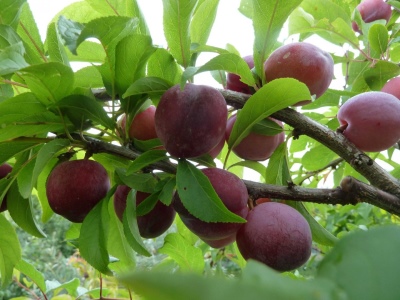
- Name synonyms: Superior
- Growth type: medium-sized
- Tree height, m: up to 5
- Fruit size: large
- Fruit weight, g: 60-75
- Fruit color: red-orange
- Pulp (consistency): dense, juicy
- Pulp color : deep orange
- Self-fertility: self-fertile
- Taste: dessert
The popular variety of the Chinese plum Superior (Superior) has quite successfully taken root in Russian gardens. Compact trees are very decorative during the flowering period, they are distinguished by their general unpretentiousness. The fruits have a universal purpose, are suitable for processing, are tasty fresh.
Description of the variety
Superior is a medium-sized Chinese plum with a tree height of up to 5 m. The crown is prone to thickening, covered with willow leaves, has an almost perfectly regular spherical shape. The flowers are white, 3-4 per bud are formed.
Fruit characteristics
Plums of this variety are large, weighing 60-75 g. The skin is colored red-orange, the pulp inside is dense, juicy, with pronounced fibers, rich and bright red hue. The bone inside the fetus is not separated from the rest of the tissues. Superior plums are suitable for long-term storage.
Taste qualities
The tasting score of this variety is 4.7 points. Their taste is dessert, very sweet, with a pleasant accompanying aroma.
Ripening and fruiting
The fruits are harvested regularly, annually. The harvesting period begins in early August. Bears fruit for a long time, the first fruits can be removed for 2 years from the moment of planting.

Yield
The variety is considered fruitful.
Self-fertility and the need for pollinators
This variety blooms in March-April, quite early. Due to self-fertility, it does not need to be necessarily planted with a number of other types of plums and cherry plums, but their presence has a beneficial effect on the taste and other properties of the harvested crop.
Growing and care
For planting, areas with neutral acidic chernozem soil are best suited, but in general, Chinese plums grow successfully on almost any soil, from sand to clay. For plants, only a sufficient amount of sunlight in the place of growth is important, it is desirable to have potential pollinators in the reach zone. Saplings are most often sold as two-year-olds, on cherry plum rootstocks.
Place Chinese plums at a distance of at least 3 m from other trees and shrubs. The soil for planting is pre-saturated with calcium using wood ash, you will need about 800 g / m2. For the cultivation of the Chinese plum, it is best to build a mound about 60 cm high so that the roots and bottom of the trunk are not exposed to the cold, humid air.
The planting hole is dug 0.5 m deep and 70 cm in diameter. Then its bottom is lined with a layer of drainage - crushed stone or gravel, soil is poured, a seedling is placed on top, placing the root collar 40-70 mm above the edge of the hole. After the land has settled during watering, it will drop, it will be flush with the soil.
Watering trees requires moderate, without frequent moisture. Pruning is carried out annually in order to rejuvenate the crown. When self-grafting, as a stock, you should choose thorny plum, cherry plum, on which the plants take root well.During the fruiting period, branches that are heavy from fruits will need additional supports.
Other care measures include watering. Due to the shallow root system of the tree, the soil does not need to be watered too much. If it remains damp at a depth of about 40 cm, watering is sufficient. When choosing dressings, you should pay attention to the composition. The presence of chlorine-containing components in it is a reason for refusing to use it.




Disease and pest resistance
According to a general assessment of the immune defense, the Superior plum is considered moderately resistant to disease, but does not suffer from shark or smallpox, unlike many similar varieties. Weakly affected by the moth. The cultivation can be carried out without the intensive use of pesticides. Particular attention will have to be paid to monitoring the condition of the root collar. It can rot.

Despite the fact that the plum is considered to be more hardy than many fruit trees, it is not immune from diseases. It is attacked by viral, fungal and bacterial infections, and parasitic insects harm it. It is necessary to notice and recognize the signs of plum disease in time. They are easier to deal with and defeat early on. Well, in order to protect the garden tree from such a misfortune in the future, preventive procedures can be carried out.
Resistance to soil and climatic conditions
The variety is winter-hardy, normally tolerates a strong drop in atmospheric temperatures. There is experience in growing it in regions with temperatures below -45 ... 55 degrees during cold periods.

Review overview
When faced with the Chinese Superior plum for the first time, summer residents are delighted with its appearance during the flowering period, when the shoots are literally covered with snow-white flowers. The variety is also praised for stable and abundant fruiting, undemanding compliance with agrotechnical measures, and excellent transportability. The tree grows rapidly, after 3 years it can gain maximum height.
Some of the disadvantages of this variety include the higher firmness of the pulp, as well as the difficulty in separating the bones. Gardeners note that branches can break under the weight of the fruit. In addition, very early flowering significantly limits the choice of climatic zones for growing this tree. Frozen buds simply crumble, leaving no ovaries. Pollination can also be complicated by the absence of insects.


































































